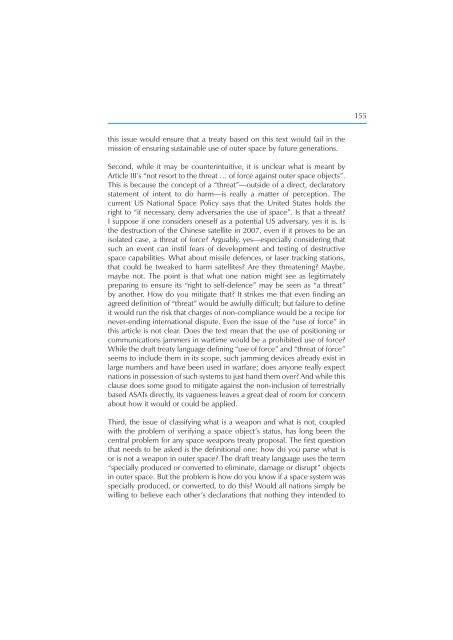Security in Space The Next Generation - UNIDIR
Security in Space The Next Generation - UNIDIR
Security in Space The Next Generation - UNIDIR
Create successful ePaper yourself
Turn your PDF publications into a flip-book with our unique Google optimized e-Paper software.
this issue would ensure that a treaty based on this text would fail <strong>in</strong> the<br />
mission of ensur<strong>in</strong>g susta<strong>in</strong>able use of outer space by future generations.<br />
Second, while it may be counter<strong>in</strong>tuitive, it is unclear what is meant by<br />
Article III’s “not resort to the threat … of force aga<strong>in</strong>st outer space objects”.<br />
This is because the concept of a “threat”—outside of a direct, declaratory<br />
statement of <strong>in</strong>tent to do harm—is really a matter of perception. <strong>The</strong><br />
current US National <strong>Space</strong> Policy says that the United States holds the<br />
right to “if necessary, deny adversaries the use of space”. Is that a threat?<br />
I suppose if one considers oneself as a potential US adversary, yes it is. Is<br />
the destruction of the Ch<strong>in</strong>ese satellite <strong>in</strong> 2007, even if it proves to be an<br />
isolated case, a threat of force? Arguably, yes—especially consider<strong>in</strong>g that<br />
such an event can <strong>in</strong>stil fears of development and test<strong>in</strong>g of destructive<br />
space capabilities. What about missile defences, or laser track<strong>in</strong>g stations,<br />
that could be tweaked to harm satellites? Are they threaten<strong>in</strong>g? Maybe,<br />
maybe not. <strong>The</strong> po<strong>in</strong>t is that what one nation might see as legitimately<br />
prepar<strong>in</strong>g to ensure its “right to self-defence” may be seen as “a threat”<br />
by another. How do you mitigate that? It strikes me that even fi nd<strong>in</strong>g an<br />
agreed defi nition of “threat” would be awfully diffi cult; but failure to defi ne<br />
it would run the risk that charges of non-compliance would be a recipe for<br />
never-end<strong>in</strong>g <strong>in</strong>ternational dispute. Even the issue of the “use of force” <strong>in</strong><br />
this article is not clear. Does the text mean that the use of position<strong>in</strong>g or<br />
communications jammers <strong>in</strong> wartime would be a prohibited use of force?<br />
While the draft treaty language defi n<strong>in</strong>g “use of force” and “threat of force”<br />
seems to <strong>in</strong>clude them <strong>in</strong> its scope, such jamm<strong>in</strong>g devices already exist <strong>in</strong><br />
large numbers and have been used <strong>in</strong> warfare; does anyone really expect<br />
nations <strong>in</strong> possession of such systems to just hand them over? And while this<br />
clause does some good to mitigate aga<strong>in</strong>st the non-<strong>in</strong>clusion of terrestrially<br />
based ASATs directly, its vagueness leaves a great deal of room for concern<br />
about how it would or could be applied.<br />
Third, the issue of classify<strong>in</strong>g what is a weapon and what is not, coupled<br />
with the problem of verify<strong>in</strong>g a space object’s status, has long been the<br />
central problem for any space weapons treaty proposal. <strong>The</strong> fi rst question<br />
that needs to be asked is the defi nitional one: how do you parse what is<br />
or is not a weapon <strong>in</strong> outer space? <strong>The</strong> draft treaty language uses the term<br />
“specially produced or converted to elim<strong>in</strong>ate, damage or disrupt” objects<br />
<strong>in</strong> outer space. But the problem is how do you know if a space system was<br />
specially produced, or converted, to do this? Would all nations simply be<br />
will<strong>in</strong>g to believe each other’s declarations that noth<strong>in</strong>g they <strong>in</strong>tended to<br />
155








